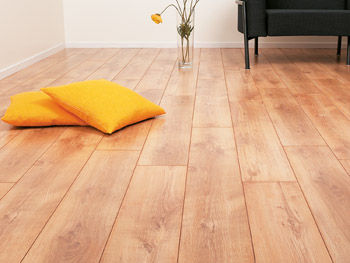 |
| Alloc's Domestic Oak |
|
By Matthew Spieler
Hicksville, N.Y.—Following another year of double-digit growth, the laminate category continues to raise eyebrows as manufacturers are achieving unprecedented realism in the product to help fuel sales.
Final figures for 2005 were not complete at press time, but the general consensus is the segment grew between 11% and 13%. From this, it is expected that laminate sales will be nearing $1.3 billion.
“We expected strong growth for the category,” said Kim Holm, president of
Mannington Mills’ residential business, “and these figures actually exceeded our expectations.”
The impressive growth appears to have carried over into 2006 based on first quarter results. “The market will maintain its present pace for the rest of the year and exhibit low double-digit growth,” noted Claes Wennerth. “Our first quarter was significantly better than in 2005, which is something we expected going into the year.”
While the category continues to grow, it also continues to face challenges beyond just rising energy costs which have affected every industry.
“Expanding worldwide manufacturing capacities and greater competition will continue to apply pressure on prices and margins,” said
David Small,
Pergo’s marketing director.
“There was one overriding challenge in laminate,” added Holm, “and that was the growth of low price, low quality imports, mostly from China.”
Wennerth noted, “Another challenge has been to differentiate and upgrade the product’s perceived value to avoid the commodity trap and Asian products that are testing the limits of U.S. intellectual property rights.”
Though Small and others admit these issues, along with rising raw material costs, will be “on-going for the foreseeable future,” the industry does not have to be bogged down by them. “Only by continuing to invest in effective marketing programs and on-going research and development will the category be successful at maintaining long-term profitability.”
This is starting to happen as Holm pointed out, the category “has shifted attention away from the low price segment and U.S. competitors have begun to focus on value added, upper-end products which provide greater realism to the consumer. And while low price is certainly still a part of the industry, it’s not a very profitable segment for anyone.”
To do this, Wennerth said companies have had to make sure everyone is on the same page. “Keeping the organization focused on what we do best—provide high quality, well designed products and superior service under the
Alloc brand as well as avoiding the commodity gutter mentality.”
For this, manufacturers have invested in upgrading their equipment to bring out designs that better mimic the real thing, and improve their supply side.
“We’ve seen more differentiated products,” Holm said, “ceramic looks, narrow planks, beveled edges. On the whole, the drive toward realism is in full swing.”
Small noted Pergo started up a “state-of-the-art DL bonding press which is capable of manufacturing ultra realistic products in a very cost-efficient manner.” Results can be seen in its Vintage Home Traditional Strip. “The demand has been exceptionally high ever since its introduction.”
At Mannington, Holm noted the company’s introduction of NatureForm Optix technology which “creates the most realistic looks using the latest advances in printing, texturing and finishing.” It was used on Revolutions Plank and Revolutions Tile “and has been extremely positive both through the channel and from the consumer.”
“We’ve brought out numerous new designs and textures, including improved wear surfaces and a unique hammered texture for our Commercial Granite,” said Wennerth. “We also expanded our warehouse and invested in more logistics software to further improve our service-delivery capability.”
In the end, it is still up to the mills, distributors and retailers to give the consumer a quality product that meets her design and lifestyle needs. “We are confident U.S. competitors can demonstrate the value of good quality upper-end products with greater visual realism and a better overall performance,” concluded Holm. “Today’s consumer is very smart and if we give her sound reasons to choose a better product, we think she will.”